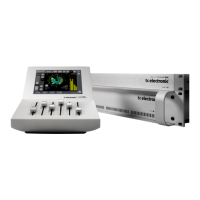52
MDX 5.1
Basic Operation
The Ref Level parameter on the Main page sets the unity
gain point for all channels (unless gain offsets are applied),
seeFig2.TheThresholdsontheDXPpagesarerelative
to Ref Level, so in this particular drawing, Ref Level is set
at-12dBFS,whilemostDXPThresholdsaresetat-16dB.
IfyouinvoketheDefeatThreshold,gainrevertstounityfor
“belowradar”inputlevels.DefeatThresholdisrelativeto
DXP Threshold. In the drawing, the Defeat Threshold is set
at -20dB
Fig 2. MDX5.1 Level Diagram for different Steer and
Threshold settings.
Defeat Threshold relates to DXP Threshold which relates to
RefLevel.LimitThresholdonlyrelatestoDigitalFullScale
output level.
Note, that the lower the DXP Threshold, or the higher a
Steer setting, the more low level boost is applied. The low
level boost can be different in different channels, and even
in different frequency bands.
Also observe that the Limiter threshold setting is not
relative to Ref Level, but always referenced to output full
scale.
Reading the Gain Meters
GainmetersinMDX5.1indicateabsolutegain.Theupper
segments of a meter gives an indication of the boost and
frequency response applied to low level signals, while
the lower segments of a meter gives an indication of the
current(dynamic)gainandfrequencyresponse,seeFig3.
Inthisexample,lowlevelsignalsaresubjecttoa5dB
boost in the Low and Hi band. The Low frequency band is
currently attenuated by 2dB, while the Mid and Hi bands
are at 0dB gain.
Fig 3. Example of MDX5.1 Gain
Meter.The meter shows max low
level gain and spectral response,
plus current gain and spectral
response.In the example, the Low
band is currently attenuated by 2 dB,
while Mid and Hi bands are at unity
gain (0 dB).
User Tips
At the beginning of a session, it can save time to set an
appropriate difference between the Ref Level parameter
and the Limit Threshold.
Wide dynamic range material for a high resolution delivery
should start with a substantial difference between the two,
forinstance15dBormore.
If the delivery resolution is low, the difference should
alsostartsmaller.Forheavilydatareducedmultichannel
broadcast using Dolby AC3, best results are typically
obtained with a 6-10dB difference between Ref Level and
the Limit Threshold. With less data reduction, such as DTS
codecs, or linear 16 bit formats, the best sound is normally
achievedwithadifferenceof8-15dB.
When significant data reduction is to be used, also be
carefulnottoallowpeaksgoingallthewayto0dBFS.
Consider bringing down the Limit Threshold between 1 and
4dB. Judge the quality of loud, spacious material passing
throughMDX5.1plusdatareductionplusdecoding,while
listening to the output of the data reduction decoder. Pay
special attention to transient distortion, and if the sound
image collapses at high levels.
In general, and especially for music mastering, start by
processing all channels by the same amount. This can
be achieved by assigning all channels to Sidechain 1, or
by using different sidechains with identical settings. Then
conclude if speech in the center channel, ambience in the
surroundsoractivityintheLFEchanneletc.needsspecial
attention and processing.

